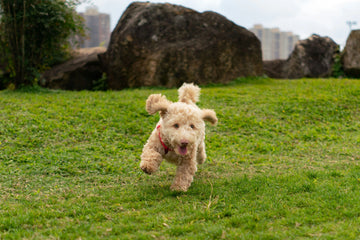If you’ve noticed your dog weak back leg or struggling to stand up, you’re not alone.
Back leg weakness in dogs is a common issue that can appear gradually or suddenly, and it can affect dogs of all ages.
The reasons range from joint problems to spinal issues, and knowing what’s behind it can help you take the right steps to support your pet.
I. Common Causes of Dog Weak Back Leg
There are many possible reasons for dog back leg weakness, including:
-Arthritis – Wear and tear in the joints, often seen in middle-aged and senior dogs, causing stiffness and reduced mobility.
-Hip Dysplasia – A structural issue in the hip joint that can cause pain and weakness over time.
-Degenerative Myelopathy (DM) – A slow-progressing spinal cord disease, common in older dogs.
-Intervertebral Disc Disease (IVDD) – Slipped or ruptured discs pressing on nerves, sometimes causing sudden paralysis.
-Nerve Injuries – Damage from accidents or falls can reduce control over the back legs.
-Muscle Loss – Reduced activity, injury recovery, or aging can lead to muscle atrophy.
II. Signs You Shouldn’t Ignore
Watch for these changes that may indicate weak back legs in dogs:
-Limping or dragging one or both hind legs
-Difficulty standing up or climbing stairs
-Reduced walking distance and increased fatigue
-Sudden collapse of the back legs
-Loss of balance or coordination
-Changes in bathroom habits

III. What You Can Do Right Away
If you notice signs of sudden hind leg weakness in dogs, take steps to make your dog safer and more comfortable:
-Reduce high-impact activities – Pause running, jumping, and rough play.
-Provide non-slip flooring – Use rugs or mats to prevent slipping.
-Assist with mobility – Use a towel, sling, or a dog lift harness for back legs to support them.
-Make essentials accessible – Keep food, water, and bedding within easy reach.
IV. Long-Term Support Options
Not every cause of back leg weakness is reversible, but there are tools to help dogs stay active and comfortable.
Dog Wheelchairs for Back Legs
These devices support the back legs so your dog can walk, run, and play.
For dogs needing more coverage, full support dog wheelchairs are available.
Smaller breeds can benefit from dog wheelchairs for small and medium dogs, designed for their body size.
Lift Harnesses
For stairs, car travel, or bathroom breaks, a harness can reduce strain on both you and your dog.
Larger dogs can use the dog carry-support harness for large dogs, while those needing all-over assistance can try a full body support dog lift harness.
Many owners use a combination: a wheelchair for outdoor activities and a lift harness indoors for short trips.
V. How to Measure Your Dog for a Wheelchair or Lift Harness
Getting the right fit ensures comfort and safety. Follow these measurement points:
Waist – Measure around the narrowest part of your dog’s body, just in front of the hind legs.
Hip – Measure the width across the hips at the widest point.
Back Height – From the ground to the top of the back at the hips.
Back Length – From the base of the neck to the base of the tail.
📌 Tip: Take measurements while your dog is standing naturally. For accuracy, have someone help keep your dog steady and comfortable.
VI. Improving Quality of Life
Gentle exercise – Short walks or swimming to maintain joint health and muscle strength.
Weight control – Less strain on joints and back legs.
Home adjustments – Non-slip mats, supportive bedding, and easy access to essentials.

A dog weak back leg condition doesn’t have to mean the end of an active life.
With the right care, supportive tools, and a safe home environment, dogs can continue enjoying walks, playtime, and companionship.
When choosing mobility aids like wheelchairs or harnesses, accurate measurements and proper fit will make all the difference.
This article is for informational purposes only and is not a substitute for professional veterinary advice.






